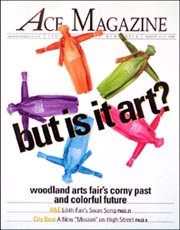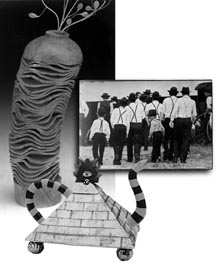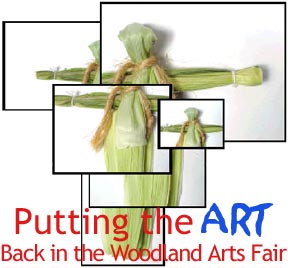Lexingtonians sure do love their cornshuck dolls and “horse art” (is that an oxymoron?). At least that’s the impression one is left with when inquiring about projected improvements at the Woodland Arts Fair.


This means a necessary switch to fine arts and fine crafts, and a steady departure from the kitschy kountry kraft that is the bread and butter of so many neighborhood “arts” fairs — the same qualities that epitomize and often stigmatize these events and scare off both real artists and real art collectors.
The question is: Is Lexington ready?
Every August, The Woodland Arts Fair attracts a colossal crowd, from those genuinely interested in the local and regional artists and craftspersons that the fair highlights, to those who just want to buy some dried flowers and a hot dog and go home.
It’s not that there’s not a place for that kind of stuff, and maybe that kind of event IS just what Lexington wants — but is the Woodland Arts Fair that place? Does it want to be an arts fair or a crafts fair — or some of both — and what’s the difference?
A Checkered, but Popular, History
The two-day event usually brings in between 35,000 and 50,000 people, but has grown stale in places and monotonous in others over the years. People know what to expect at the Woodland Arts Fair— an array of arts and crafts ranging from pottery to painting to photography, but also your fair share of “Krafts.”
However, this year, the Lexington Art League is beginning an evolutionary process of sorts—trying to bring in more quality artists and create a new atmosphere for the fair so people will want to come out to the event and not just fall upon it by happenstance…..because if they’re going to call it an Arts Fair, it stands to reason they should have ART there.


| Pictured Above: Newcomer Roger D.Schultz is bringing his unique wood pieces to this year’s fair. Also, featured this year are photos by Jim Durham (top right) and the pottery of M.Tiller (top left). |
The fair first began in 1976 and has since then become one of the most well-known juried art fairs in the state of Kentucky (only two come to mind, this one and Waterside in Louisville).
Although the goal of the jurying process is to select high quality, unique arts and crafts for the fair, it hasn’t occurred every single year—allowing grandfathering to take place. So, once a cornshuck, always a cornshuck. Historically, the show has only been completely rejuried every three years, and this wasn’t one of those years. Next year, and from now on, the show will be completely rejuried every single year by outside expert jurors.
The Lexington Art League’s Woodland Arts Fair Committee juried in new exhibitors this year since there weren’t many openings; there were only about 15 slots. Slides were projected anonymously, point values were assigned and openings in various media were filled based on the scores.
“A lot of people don’t know that this will be the 24th year of the WAF,” says Don Ament, chairperson of the Woodland Arts Fair Committee, “When the show got started back in the mid 70s, art fairs around the country were mostly just an excuse for some artists to get together and hang up their art on a clothesline or whatever. Almost all the artists had regular jobs or other sources of income, so if they sold something great, if not, great.
—Gay Reading, curator, Hunt-Morgan House |
“In the last ten years or so, the art fair business has really grown up. Lots of artists are now supporting themselves, some very well, exclusively from outdoor shows. These are people with high quality work, gallery level displays, and plenty of business savvy to put on whatever hat they need at the time to make it all work.”
Woodland couldn’t keep up with the changes over these past few years. The entire event has been run by a staff of two or three, and a few volunteers. So the decision was made this year to form a Woodland Arts Fair Committee (WAF), composed of arts professionals and exhibiting artists, to help bring the show up to speed, both in terms of “the quality of the exhibit, and the quality of the experience for the artists,” according to Ament.
“It’s not all going to happen at once, especially considering the long history. Like life, it’s a work in progress,” says Ament.


.
“The standardization is an upgrade. This will become particularly important next year when we rejury the entire art fair. We had juried everyone in in ‘97, so if you were juried in in ‘97 and ‘98 you can come back. Next year and from each year forward we’re going to rejury on an annual basis so there won’t be any grandfathering and we’re in the process of adopting the NAIA standards so we can take this show from a regional art show to a national art show,” McGee says.
NAIA Secretary, Kathleen Eaton says that their organization doesn’t have standards per se, but rather they function as an advocacy group that educates and fosters excellence among the visual arts.
“The art fair in a lot of ways has operated in a sort of a vacuum, not keeping up with what’s been happening, so we’re trying to bring it more up to speed,” comments Ament. “The biggest thing we need to do is to learn how to promote the fair and advertise the fair to the right kind of people, people who aren’t just looking to come out and eat a hot dog or walk their dog while thinking they’re ‘supporting’ the arts. We want to reach people who haven’t considered the fact a street fair can be a legitimate venue.”
“We’re looking for a balanced fair this year. Since we had a limitation on the ones that were grandfathered in, it won’t be as balanced as it will be next year when you’ll see some big changes in terms of how many from each medium is in the show,” says McGee, “We tried to get a good mixture this year….we have ceramics, fiber, glass, painting, photography, jewelry, computer art , printmaking, leather, paper, quite a broad variety of [media].”
| “The Arts Council does not make a distinction between high art and low art. I think there has to be a balance… you don’t have to make a choice between craft and art because I think crafts are art, but you have to make the distinction between high quality and poor quality.”
—Dee Fizdale, executive director, LACC |
McGee says the WAF Committee is shooting for improving the quality rather than the quantity. They voluntarily cut back from about 180 artists last year to 150 artists this year, 76 of whom are Kentucky artists. Thirteen states are represented.
To chuck the cornshucks?
OK, so it may take a while for these changes to occur at the Woodland Arts Fair. After all, you can’t rush quality. Once the well-established grandfathering process dies out, real progress can be made according to McGee. As for the future of the fare available, well, you’ll have to wait and see. In evolving into a fine arts and fine crafts event, the WAF plans to make the distinction between fine crafts and plain crafts (such as country crafts which don’t really have a place at an arts fair). However, this is where the heated debate begins. Are the definitions that clear cut? Do Lexingtonians just want their Korn?
“There are a lot of venues around here where you can sell little kitschy, crafty things and some of that has been at Woodland over the years,” Ament admits.
“The thing that’s kind of interesting, and we’ll see how it goes, is will the public come out and support art? Most of the artists that do these type of art fairs, the ones that are really good, they do it full time. So, they need to go to shows where they can make some money. If we bring in top flight exhibitors and they don’t sell anything, they’re not going to come back.”
Ament says that “some of that kind of stuff” will still be there this year. He doesn’t know if it will ever be fully eliminated from the fair or even if the committee wants to eliminate it entirely, but the probability is high.
“I think we will [eliminate cornshuck dolls] because you can get them at a lot of places, I don’t want to say that as a big negative or put that kind of artwork down because it has its place,” Ament says.
“That’s something I associate with the Berea Fair frankly,” says McGee, “If we have some cornshuck dolls there this year I apologize—This is the last year for grandfathering. I’ll be the first to admit that cornshuck dolls don’t belong in an arts fair, but I‘m not going to make a statement on whether or not I consider it an art or craft. I doubt you’re going to see any [of them] there next year…..we are trying to make this an arts fair.”
The Arts Community Weighs In
Wyman Rice, a potter who has shown his work at the Woodland Arts Fair for about ten years now, says there’s a market for those items, but not necessarily at a fair that’s focused on fine arts and fine crafts.
“It’s sometimes hard to make a distinction between art and craft and there’s always an ongoing debate on how to define those terms. My work is nonfunctional decorative things and considered more art probably than craft, but it’s a hard distinction to make.”
“I think art should just be taken in at the higher end. Fine art is individually hand produced and an original work, and to me it can be a wide range of price and quality. We need to have a well rounded arts fair, it would be a shame to try to change it,” says Michael Shatterly, co-owner of the Kentucky Gallery of Fine Crafts and Art.
Frankie York, owner of New Editions Gallery agrees that arts fairs like Woodland shouldn’t limit itself to one or the other (fine arts or crafts).
“You can’t just have the high end stuff because even if people wanted it, they couldn’t necessarily afford it, so then it’s just frustrating,” York says.
“I know there’s a trend, something fashionable about putting crafts and fine arts together. It doesn’t improve the quality if you have paintings instead of baskets or cornshuck dolls because if you have some rotten paintings, the quality goes down in my book,” says Dee Fizdale, executive director of the Lexington Arts and Cultural Council, “Maybe an arts and crafts fair isn’t the place to go for pieces of fine art. I think quality whether it’s craft or ‘fine’ art is important. The Arts Council does not make a distinction between high art and low art. I think there has to be a balance… you don’t have to make a choice between craft and art because I think crafts are art, but you have to make the distinction between high quality and poor quality.”
Gay Reading, curator of the Hunt-Morgan House, says everything’s a craft, but not everything’s art. Decorative arts are considered art but are also useful and it’s the element of design in it according to Reading, who is also the properties manager at Bluegrass Trust for Historic Preservation. Pure crafts are without the art element.
“A lot of craftsy stuff tends to be kitschy….like thoroughbred people and saddlehorse people, crafters and artists don’t want to be in the same show,” Reading says, “Art doesn’t have to be beautiful, but it probably shouldn’t be cute.
“I think it’s nice to have a mixture and there’s a great movement in our nation for crafts, not the crafty crafts, but the fine craft things that are created as an art form rather than cutting out a piece of pine board into the shape of a horse and painting a couple of eyes on it and gluing a tale on it and then selling the sucker for about 10 dollars,” says James Durham, a photographer who will be at the Woodland Arts Fair for the second time.
A newcomer to the fair, Roger Shultz , a woodturner from Indiana, doesn’t consider low craft to be art. He fears people would rather have the low end inexpensive items like the country crafts rather than fine art.
“I’ve been at shows where there will be two lines of people waiting to buy dried flower arrangements and in one show they were dumping the stuff out of garbage bags and people were jumping in the piles to get it. Sometimes you’ll see people running around with swatches of fabric trying to find something that will match their couch,” says the bewildered Shultz.
Jane Steerman, a Woodland Arts Fair veteran and jewelry maker says she always felt they’ve had good artists there for the most part.
“In the last few years, they have let in a few I personally wouldn’t let in, but that’s my own personal opinion. I guess it depends on what kind of art you like, everyone’s got their own opinion. There’s one fair that I stopped going to because it became very commercial and they did not keep the quality up….it was in Louisville, but I’d be blackballed forever if I mentioned which one,” Steerman says.
Lexington or Bust
According to the Lexington Arts and Cultural Council, arts are the ninth largest employer in Lexington—and the arts (both visual and performing) have a $20 million dollar economic impact on this community. Yet, ironically, many artists and galleries are struggling to keep afloat in Lexington.
There may be somewhat of a demand for art in this town, but it isn’t felt all too often and there’s definitely not a high enough demand for local artists (though the supply is ample). It seems that people would rather travel to Budapest to find their art, rather than looking at what Lexington has to offer.
Terri DeAtley, program coordinator at ArtsPlace, says “I know there are plenty of central Kentucky artists who do fine art and people can start looking here before they look outside of the state of Kentucky for fine arts because it exists right here. I think it’s important to support the artists in the community.”
“For sales purposes, people are not ready to buy the more expensive fine art, I don’t see that here [at ArtsPlace]. I think they want to look at it and have it available to look at, but I don’t think they’re ready to buy it. It doesn’t seem like the people who go to arts festivals and arts fairs and crafts fairs are going to be the people who buy $1,000 pieces of art,” DeAtley says, “Most of what we have sold has been things under $500.”
Frankie York concurs, “I think generally people are more willing to pay that in big places like New York.”
Local arts scion Heike Pickett suggests, “I don’t do market research, [but] the economics of the fine arts business is such that it’s not a simple thing —it’s not a necessity for people. Crafts [may be] easier because it starts from a more utilitarian point of view…we all have to justify how we spend our money.”
Gayle Cerlan (of Tower Cerlan Gallery, located in the space Heike Pickett vacated to relocate to Versailles), says, “I think there’s a demand for art here. We have a selective audience of course, but part of that has to do with our culture [where] you can go into Wal-Mart and buy what looks like a glass blown vase or print and people think it’s art and they’re getting a deal. We have folk art and fine art.”
“I think that we as a gallery have a tough time. A lot of people don’t know the wealth of the quality of art that Kentucky artists produce and that we have here in town. A lot of people who spend money on art buy their art out of town, but there’s a core of people who believe in it [local art] and support it and that’s what keeps our business going,” Shatterly says, “People are hesitant to make the investment to buy an original piece of art, but there’s some sort of mentality of buying a print or something that’s familiar to them.”
Don Ament adds, “With all the construction going on around here, there are tons of blank walls and empty shelves just waiting for artwork. The question is what kind of art is going up on these walls? An article in Art Business News stated that 70 percent of the framed “art” sold in our country is sold at furniture stores. We’re talking low quality, mass produced stuff.”
Dee Fizdale concurs, “I wish people would feel as comfortable buying original art for their homes as they do buying furniture.”
Ament continues, “That’s why we’re trying to get the word out that there is serious art at Woodland.”
Ament says there can be more of a demand for art if people learn more about what they’re looking at, and that’s one of the advantages of arts shows because you meet the person that made the work— a positive benefit.
There’s definitely a lack of arts activities in the summer according to DeAtley, who says there is a perception that the whole calendar revolves around the academic calendar with the University of Kentucky and Transylvania University, so a summer activity such as Woodland is good for the arts in Lexington.
“I absolutely see a demand for art in Lexington. It’s growing as people’s lives become more complicated in the fast paced environment we live in, art is going to take a much more important role,” says McGee “I think Kentucky has always had an excellent reputation for crafts and is starting to get a reputation for its art as well outside of the state. I think that’s what distinguishes Woodland from other art fairs in the area because we focus on the high end of craft and art itself and we’re trying to represent the best of the both.”
So, if you build it, will they come…..
The Woodland Arts Fair is changing some things to improve the show from the artists’ point of view as well. They are going to be giving some cash merit awards to the artists and hosting a reception Saturday night for them.
“The Woodland Arts Fair is the only time I show my work in Lexington. I don’t show my work in any galleries, I’ve done really well there and my stuff is not cheap and I consider it to be fine art. We have some artists that do really well,” says Ament, a photographer.
“I wouldn’t come back if I didn’t sell well,” says Steerman, who has been involved with the fair for 20 years. “I don’t think there needs to be change.”
“A change is a good place to start, I don’t think Lexington’s a town that supports anything beyond pretty things that match your couch,” says Ilona Szekely-Tackett, an art educator and artist, “And people have the money to spend here.
Szekely-Tackett, a former Lexingtonian, says the WAF Committee should be calling it the Arts and Crafts fair if they’re going to have things like cornshuck dolls.
“You can’t really be a modern artist if you don’t have a wide range of what you think art is, but I have a problem with saying crafts are the same things as art.”
Role Models?
The Woodland Arts Fair has some pretty big shoes to fill if it wants to be considered a reputable Arts Festival. It might just want to sneak a peak at some other well-known fairs on a national level for some inspiration.
“There’s a show in Cleveland called Cain Park. That’s about the same size as Woodland. It’s booth after booth of blow your mind stuff,” says Don Ament, “There’s sculptures that cost around $25,000 and huge oil paintings, and people come out and buy this stuff. Over the years, the show has developed a tradition and following and people know the show has great stuff. I don’t know if Woodland will ever evolve into that level, but it’s going to be an education process.”
The really big festivals are Cain Park in Cleveland, Ann Arbor in Michigan, Folk Fest in Georgia and Cherry Creek in Denver. According to Jerry McGee, these are the standards in the industry. The Woodland Arts Fair is following in their footsteps, for these mammoth fests religiously consult the National Association of Independent Artists (NAIA)—something Woodland is doing for the first time this year.
“These standards are the goal to shoot for in order to get high quality,” says McGee, “I see our quality continuing to improve, but I don’t know if we’ll increase our size necessarily. However, as our quality improves, we may consider increasing the size, but right now we like the size of it.”
John Begley, executive director of the Louisville Visual Art Association, says the Waterside Festival in Louisville always attracts a high quality group of people.
“The population of people who buy art in New York on a percentage basis probably isn’t that much different from Lexington or Louisville. There may be 15 percent of people willing to buy cornshuck dolls and 7.5 percent who are willing to buy more than that, but if you have a good crowd and the right number of exhibitors….that’s still going to be better,” Begley says.










